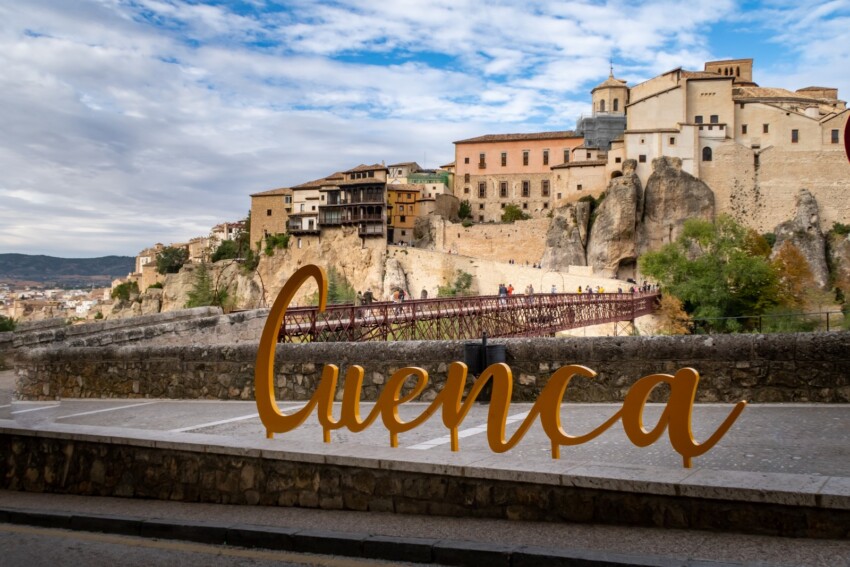

In the Spanish hinterland, only 170 km from Madrid, hides a charming town that seems to be suspended between rocks: it is Cuenca, whose historic centre is perched on a promontory at the junction of two deep gorges.
The new part lies at the foot of the hill and is uninteresting, but the centre is a different story. The historic buildings are perfectly integrated with the surrounding nature, almost as if they were a spontaneous continuation of it, and the narrow streets are squeezed between tall houses with wooden balconies overlooking the gorge, which have become known as Casas Colgadas (Suspended Houses) because of their very special position.
For its admirable fusion of nature and architecture Cuenca has been declared a Unesco World Heritage Site and has become one of the most popular day trips from Madrid.
Stay a while longer: medieval palaces, a modern bridge built over the stone arches of an ancient bridge, spectacular views and interesting museums, including two not to be missed. If you are a romantic soul, don’t miss a night walk to admire the famous, expertly lit cliff-top houses; if you prefer an adrenaline rush, climb the area’s rock walls or explore the valley’s gorges with a canyoning instructor.
Start dreaming up your holiday in Cuenca by marking down the must-see attractions.
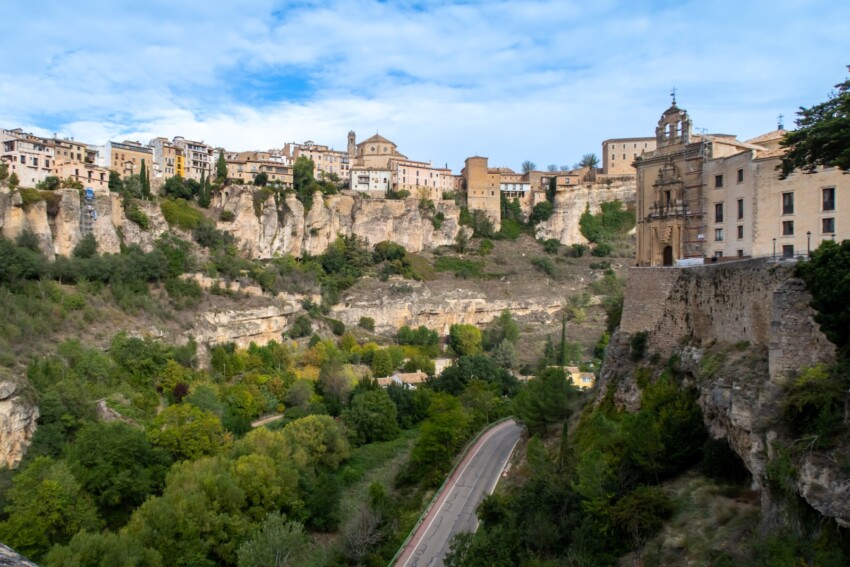
Cuenca’s top attraction are the Casas Colgadas (translated into Suspended Houses or Hanging Houses), which have become the symbol of the city.
They are old houses perched atop one of the walls that form the gorge of the Huécar River and have beautiful wooden terraces. Depending on how one looks at them, they may appear to be a natural continuation of the rock or a man-made construction in precarious equilibrium.
The best view of the facades of the Suspended Houses is from Puente de San Pablo, a vertiginous iron and wooden bridge built in 1902 to replace an old five-arched stone bridge dating back to the 16th century. Like its predecessor, the new Puente de San Pablo allows one to cross the Huécar gorge, uniting the old town with the former Convento de San Pablo (now a luxury hotel).
In the past, hanging houses occupied the entire crest of the wall, but today only three of the original houses remain. One of these houses the best museum in Cuenca: the Spanish Museum of Abstract Art.
The interior of the museum does not seem to have anything to do with the Tibetan temple-like appearance that characterises the facades of the Suspended Houses: the galleries are spacious and well lit and the exhibition is well curated.
The museum collection, one of the most interesting of its kind in Europe, includes works by Spain’s most important abstract artists including Fernando Zóbel (founder of the museum), José Guerrero, Antoni Tàpies and Eusebio Sempere. Portraits of Brigitte Bardot and Philip II by Antonio Saura are also on display.
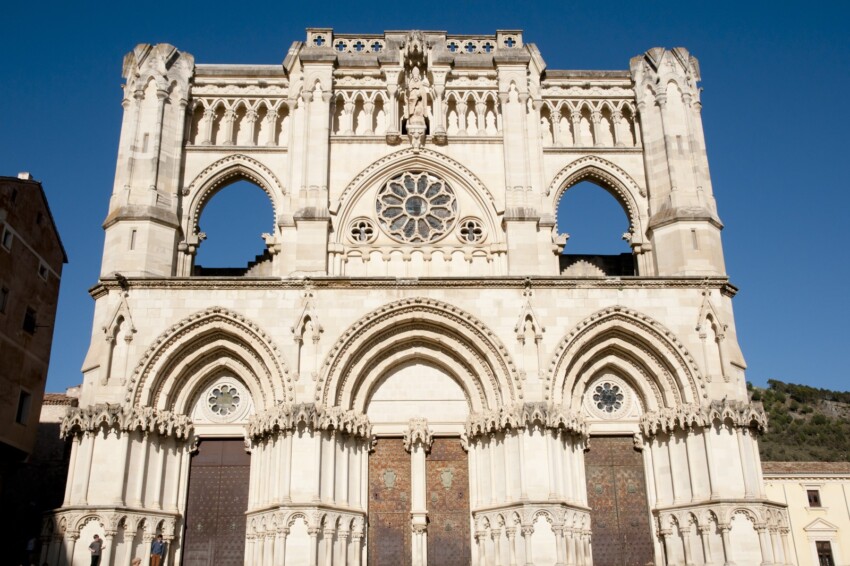
The magnificent Cathedral of Cuenca has an impressive façade that looks very old: it is actually a neo-Gothic building from 1902, but its ‘young’ age in no way detracts from its charm.
The rest of the building is authentically old: the church was built in 1177 during the Reconquista on the site where Cuenca’s main mosque once stood. Inside you can admire beautiful cloisters and a wooden ceiling coloured in pastel shades.
From the Parador de Cuenca starts a 3 km walk to the Cerro del Socorro, the statue of Christ the Redeemer that dominates the hill opposite the Huécar gorge. At night you can see it illuminated without any effort, but it is worth the climb to the top.
The path is largely shady and the view both along the route and from the Mirador (lookout) at the foot of the statue is truly spectacular. The route is marked by 14 stations reminiscent of the Stations of the Cross.
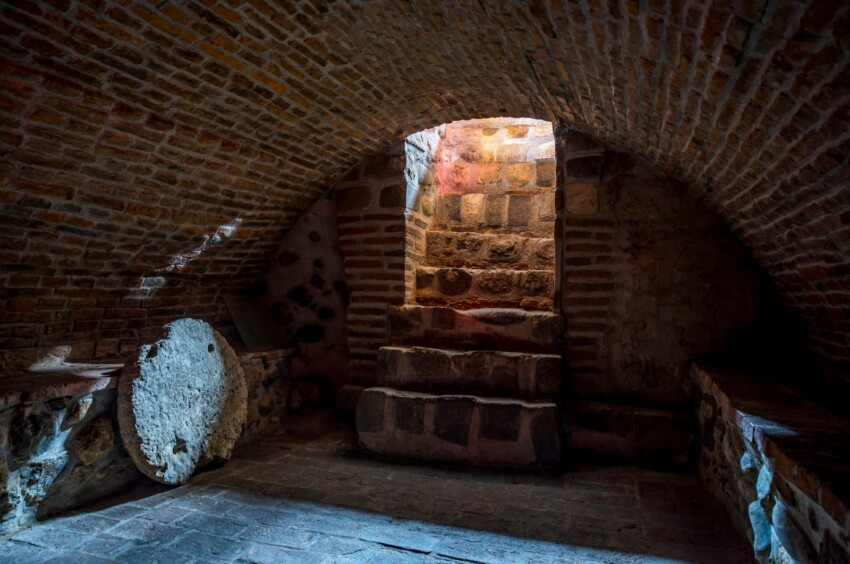
One thinks of Cuenca as a city high on a hill, to be admired looking upwards, but the city also has an underground dimension to be discovered: a network of passageways and tunnels beneath the historic centre that served as aqueducts, crypts and air-raid shelters during the Spanish Civil War.
Recently restored and equipped with walkways and explanatory panels, they can only be visited with a guided tour in Spanish, highly recommended!
Never managed to plan a holiday in Spain during Easter week? Console yourself with a visit to the Museo de la Semana Santa in Cuenca: it’s the closest you can get to experiencing first-hand the exciting Holy Week celebrations held throughout the country.
Spread over two floors, it is an audiovisual museum where you can watch numerous films about the processions held locally and admire a collection of religious parade costumes, crosses and sacred art objects.
Little remains, but it is nonetheless an impressive sight. The Cuenca Castle is a Christian fortress built at the time of Philip II (16th century) as an extension of a 10th-century Arab wall. Today, sections of the wall, two towers and the Bezudo Arch, the majestic arch that marked the entrance to the city, are still visible.
Fascinated by the famous historical buildings, few tourists bother to discover the modern side of Cuenca. This is a pity because the city is an important centre for modern art in Spain, rich in galleries and cultural ferment.
For lovers of modern art, the must-see museum in Cuenca is the Antonio Pérez Foundation, housed in the former Convento de Las Carmelitas.
The collection of this huge museum includes a wide selection of works by Antonio Saura and artists from the 1950s and 1960s, as well as some works by the most famous international pop artist, Andhy Warhol. Be prepared for anything: some works in this museum will amuse you, some will inspire you, and some will probably leave you perplexed.
In the following map you can see the location of the main places of interest mentioned in this article.
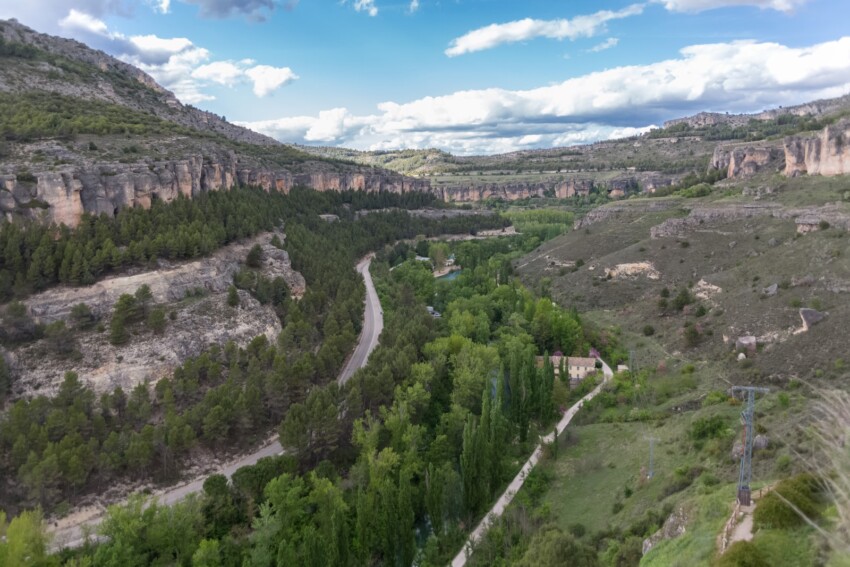
Cuenca’s privileged location, surrounded by spectacular nature, offers numerous opportunities for excursions in the surrounding area. Renting a car is recommended to best explore the region.
Ciudad Encantada, located 28 km from Cuenca, is a unique karstic landscape formed by limestone rocks shaped by erosion over millions of years. This ‘geological park’ offers a well-marked route of about 3 km among rock formations that resemble familiar shapes such as mushrooms, boats, crocodiles and human faces. It is a perfect destination for a half-day excursion, ideal for families and photography enthusiasts.
The Cuervo River Springs, about 60 km from Cuenca, offer some of the most spectacular natural scenery in the region. The main waterfall, which gushes directly from the rock creating travertine formations, is particularly impressive in spring or after rainfall. The park has well-maintained trails and picnic areas, perfect for a day out in nature.
The Callejones de Las Majadas, 45 km from the city, are another extraordinary example of karstic erosion. This natural labyrinth of corridors and passages between high rock walls offers a fascinating hiking route. The rock formations, similar to those in Ciudad Encantada but less touristy, create surreal scenery perfect for trekking and photography.
Laguna de Uña, just 12 km from Cuenca, is a small lake of karstic origin surrounded by lush vegetation. It is an ideal place for birdwatching and peaceful walks, with a path surrounding the lake. The area is perfect for a picnic and offers the possibility of licensed sports fishing.
The picturesque medieval village of Albarracín, located 150 km from Cuenca in the province of Teruel, is considered one of the most beautiful in Spain. Its ochre-coloured houses clinging to the mountain, medieval walls and castle create a unique urban landscape. The village is also famous for its red sandstone walls, making it a popular destination for rock-climbing enthusiasts.
Taking advantage of its proximity to Madrid, many tourists visit Cuenca on a day tour. This is a pity because the special features that have made this city famous are best appreciated when the sun goes down and the historical buildings are spectacularly lit up. The spectacle of the casas colgadas at night is priceless.
To sleep in Cuenca, one can choose to stay in the historical centre or in the new town: both have advantages and disadvantages.
The historic centre, or upper city, is recommended for those looking for something romantic and atmospheric. Reaching it by car is, however, very inconvenient, so those travelling by private vehicle are advised to sleep in the new (or lower) town, which is less characteristic but more convenient and with a greater choice of hotels and B&Bs in the different price ranges. Accommodation in the centre is generally more expensive.
The easiest and cheapest way to get to Cuenca is to book a cheap flight to Madrid and from there travel by hire car, bus or train. Trains from Madrid take between one and three hours to get to Cuenca, depending on the type of train; the bus is about the same price as a regional Madrid-Cuenca train and takes about two and a half hours.
Another possibility is to take a flight to Valencia: this city is also connected to Cuenca by direct buses and trains.
If travelling by train, pay attention to the station of departure because there are two train stations in Cuenca: Estación de Cuenca-Fernando Zóbel is served by high-speed AVE trains while regional trains depart from Estación de Cuenca. Both are located outside the upper city but are served by local buses.
From Cuenca one can easily reach all the main towns in Castile-La Mancha by car or public transport, including Toledo and Albacete.
What's the weather at Cuenca? Below are the temperatures and the weather forecast at Cuenca for the next few days.
Cuenca is a city located in the Castile-La Mancha region. It is about two hours' drive from Madrid and about two and a half hours from Valencia.